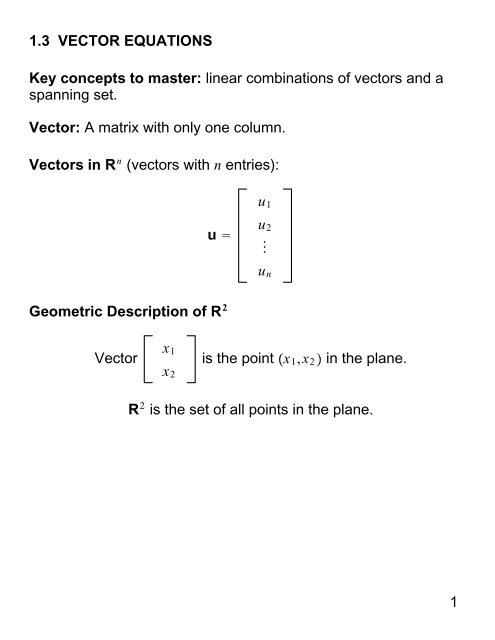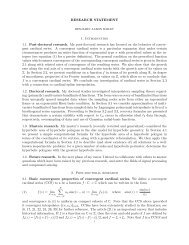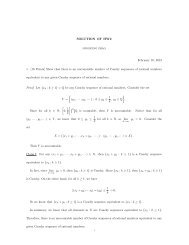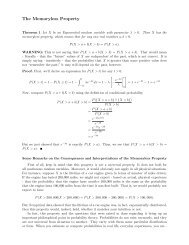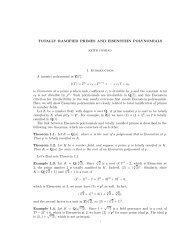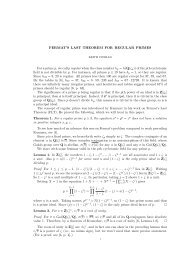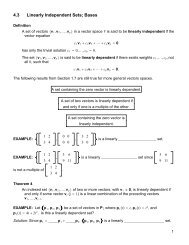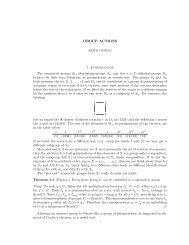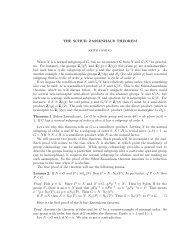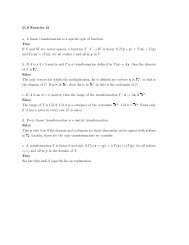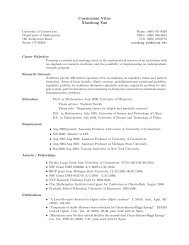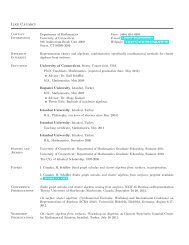1.3 VECTOR EQUATIONS Key concepts to master: linear ...
1.3 VECTOR EQUATIONS Key concepts to master: linear ...
1.3 VECTOR EQUATIONS Key concepts to master: linear ...
You also want an ePaper? Increase the reach of your titles
YUMPU automatically turns print PDFs into web optimized ePapers that Google loves.
<strong>1.3</strong> <strong>VECTOR</strong> <strong>EQUATIONS</strong><br />
<strong>Key</strong> <strong>concepts</strong> <strong>to</strong> <strong>master</strong>: <strong>linear</strong> combinations of vec<strong>to</strong>rs and a<br />
spanning set.<br />
Vec<strong>to</strong>r: A matrix with only one column.<br />
Vec<strong>to</strong>rs in R n (vec<strong>to</strong>rs with n entries):<br />
u <br />
Geometric Description of R 2<br />
Vec<strong>to</strong>r<br />
x1<br />
x2<br />
u1<br />
u2<br />
<br />
un<br />
is the point x1,x2 in the plane.<br />
R 2 is the set of all points in the plane.<br />
1
Parallelogram rule for addition of two vec<strong>to</strong>rs:<br />
If u and v in R2 are represented as points in the plane, then<br />
u v corresponds <strong>to</strong> the fourth vertex of the parallelogram<br />
0<br />
whose other vertices are 0, u and v. (Note that 0 <br />
0<br />
EXAMPLE: Let u <br />
1<br />
3<br />
and u v are given below:<br />
x2<br />
4<br />
3<br />
2<br />
1<br />
and v <br />
2<br />
1<br />
. Graphs of u,v<br />
1 2 3 4 x1<br />
Illustration of the Parallelogram Rule<br />
.)<br />
2
EXAMPLE: Let u <br />
graph.<br />
1<br />
2<br />
3<br />
2<br />
1<br />
. Express u, 2u, and 3<br />
2<br />
u on a<br />
−2 −1 1 2 x1<br />
−1<br />
−2<br />
−3<br />
x2<br />
4<br />
3
Linear Combinations<br />
DEFINITION<br />
Given vec<strong>to</strong>rs v1,v2,,vp in R n and given scalars c1,c2,,cp,<br />
the vec<strong>to</strong>r y defined by<br />
y c1v1 c2v2 cpvp<br />
is called a <strong>linear</strong> combination of v1,v2,,vp using weights<br />
c1,c2,,cp.<br />
Examples of <strong>linear</strong> combinations of v1and v2:<br />
3v1 2v2,<br />
1<br />
3 v1, v1 2v2, 0<br />
4
EXAMPLE: Let v1 <br />
2<br />
1<br />
and v2 <br />
2<br />
2<br />
. Express<br />
each of the following as a <strong>linear</strong> combination of v1 and v2:<br />
a <br />
0<br />
3<br />
, b <br />
4<br />
1<br />
, c <br />
6<br />
6<br />
, d <br />
−8 −6 −4 −2 2 4 6 8 x1<br />
−2<br />
−4<br />
−6<br />
−8<br />
x2<br />
8<br />
6<br />
4<br />
2<br />
7<br />
4<br />
5
EXAMPLE: Let a1 <br />
and b <br />
1<br />
8<br />
5<br />
.<br />
1<br />
0<br />
3<br />
, a2 <br />
4<br />
2<br />
14<br />
, a3 <br />
Determine if b is a <strong>linear</strong> combination of a1, a2, and a3.<br />
Solution: Vec<strong>to</strong>r b is a <strong>linear</strong> combination of a1, a2, and a3 if can<br />
we find weights x1,x2,x3 such that<br />
Vec<strong>to</strong>r Equation (fill-in):<br />
Corresponding System:<br />
x1a1 x2a2 x3a3 b.<br />
x1 4x2 3x3 1<br />
2x2 6x3 8<br />
3x1 14x2 10x3 5<br />
3<br />
6<br />
10<br />
,<br />
6
Corresponding Augmented Matrix:<br />
1 4 3 1<br />
0 2 6 8<br />
3 14 10 5<br />
<br />
1 0 0 1<br />
0 1 0 2<br />
0 0 1 2<br />
<br />
x1 ___<br />
x2 ___<br />
x3 ___<br />
Review of the last example: a1, a2, a3 and b are columns of the<br />
augmented matrix<br />
Solution <strong>to</strong><br />
1 4 3 1<br />
0 2 6 8<br />
3 14 10 5<br />
<br />
a1 a2 a3 b<br />
x1a1 x2a2 x3a3 b<br />
is found by solving the <strong>linear</strong> system whose augmented matrix is<br />
a1 a2 a3 b .<br />
7
A vec<strong>to</strong>r equation<br />
x1a1 x2a2 xnan b<br />
has the same solution set as the <strong>linear</strong> system whose<br />
augmented matrix is<br />
a1 a2 an b .<br />
In particular, b can be generated by a <strong>linear</strong> combination of<br />
a1,a2,,an if and only if there is a solution <strong>to</strong> the <strong>linear</strong><br />
system corresponding <strong>to</strong> the augmented matrix.<br />
8
The Span of a Set of Vec<strong>to</strong>rs<br />
EXAMPLE: Let v <br />
3<br />
4<br />
5<br />
. Label the origin<br />
<strong>to</strong>gether with v, 2v and 1.5v on the graph below.<br />
x1<br />
x3<br />
v, 2v and 1.5v all lie on the same line.<br />
Spanv is the set of all vec<strong>to</strong>rs of the form cv.<br />
Here, Spanv a line through the origin.<br />
0<br />
0<br />
0<br />
x2<br />
9
EXAMPLE: Label u, v, u v and 3u 4v on the graph below.<br />
x2<br />
x3<br />
u, v, u v and 3u 4v all lie in the same plane.<br />
Spanu,v is the set of all vec<strong>to</strong>rs of the form x1u x2v.<br />
Here, Spanu,v a plane through the origin.<br />
x1<br />
10
Definition<br />
Suppose v1,v2,,vp are in R n ; then<br />
Spanv1,v2,,vp set of all <strong>linear</strong> combinations of<br />
v1,v2,,vp.<br />
Stated another way: Spanv1,v2,,vp is the collection of<br />
all vec<strong>to</strong>rs that can be written as<br />
where x1,x2,,xp are scalars.<br />
EXAMPLE: Let v1 <br />
x1v1 x2v2 xpvp<br />
2<br />
1<br />
(a) Findavec<strong>to</strong>rinSpanv1,v2.<br />
and v2 <br />
(b) Describe Spanv1,v2 geometrically.<br />
4<br />
2<br />
.<br />
11
Spanning Sets in R 3<br />
x 1<br />
x3<br />
v1<br />
v2<br />
v2 is a multiple of v1<br />
Spanv1,v2 Spanv1 Spanv2<br />
(line through the origin)<br />
x2<br />
12
x2<br />
EXAMPLE: Let v1 <br />
v2<br />
x3<br />
v1<br />
v2 is not a multiple of v1<br />
x1<br />
Spanv1,v2 plane through the origin<br />
4<br />
2<br />
2<br />
Spanv1,v2 a line or a plane?<br />
and v2 <br />
6<br />
3<br />
3<br />
. Is<br />
13
1 2<br />
EXAMPLE: Let A 3 1 and b <br />
0 5<br />
the plane spanned by the columns of A?<br />
Solution:<br />
A <br />
1<br />
3<br />
0<br />
Do x1 and x2 exist so that<br />
2<br />
1<br />
5<br />
Corresponding augmented matrix:<br />
1 2 8<br />
3 1 3<br />
0 5 17<br />
<br />
1 2 8<br />
0 5 21<br />
0 5 17<br />
b <br />
<br />
8<br />
3<br />
17<br />
8<br />
3<br />
17<br />
1 2 8<br />
0 5 21<br />
0 0 4<br />
So b is not in the plane spanned by the columns of A<br />
. Is b in<br />
14


